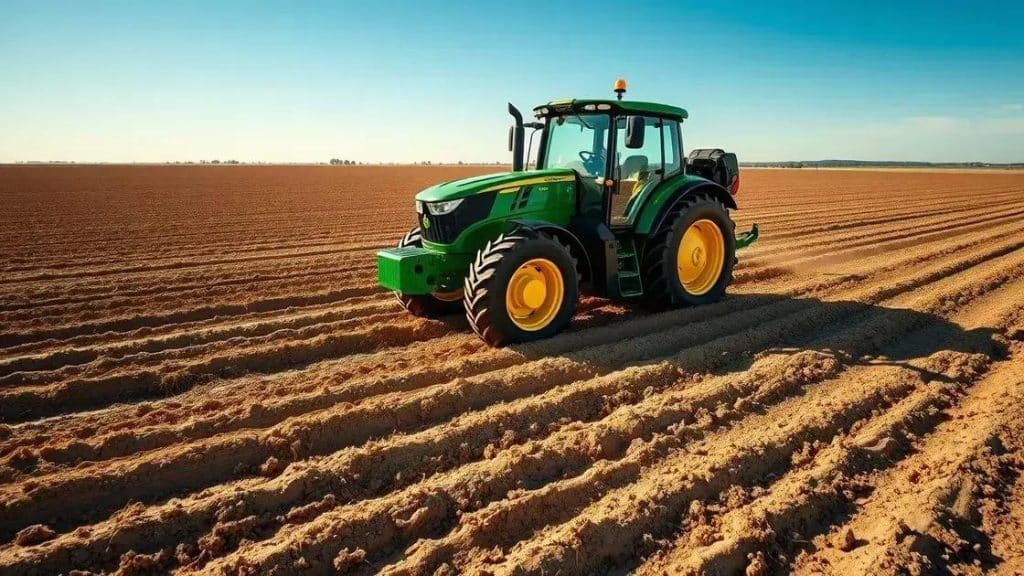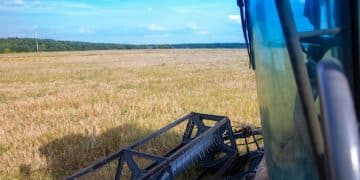GPS-guided tractor steering technology: the future of farming

GPS-guided tractor steering technology enhances farming efficiency by improving accuracy in planting, reducing resource waste, and enabling cost savings, thereby transforming agricultural practices for greater productivity.
GPS-guided tractor steering technology is revolutionizing modern agriculture. Ever thought about how farmers can achieve greater efficiency and precision? This innovation makes a remarkable difference in crops and resource management.
Understanding GPS-guided steering in agriculture
Understanding GPS-guided steering technology in agriculture is essential for farmers looking to enhance productivity. This innovative approach utilizes satellite signals to guide tractors automatically, reducing human error.
What is GPS-guided steering?
GPS-guided steering is a system that helps tractors stay on a precise path. It works using signals from satellites and various sensors to direct the vehicle accurately, allowing for efficient planting and cultivating.
Key features of GPS-guided steering
- Precision: Achieves accurate alignment for planting and tilling.
- Efficiency: Reduces overlap and wasted resources.
- Ease of use: Simplifies the operator’s workload.
As farmers adopt this technology, they’re experiencing significant benefits. With GPS-guided steering, they can operate tractors longer with less fatigue. Moreover, this system allows for better field mapping, which is crucial for maximizing crop yields. This is a game changer, especially in larger fields.
The advantages of GPS-guided steering
One of the biggest advantages is the reduction of input costs. By minimizing waste and ensuring that every seed is planted accurately, farmers can boost their profits. Additionally, it leads to more sustainable practices by optimizing the use of fertilizers and pesticides.
Farmers are increasingly recognizing these advantages as critical to their success in a competitive market. The return on investment for these systems can be realized quickly through increased production and reduced operational expenses.
Benefits of GPS-guided tractor technology

The benefits of GPS-guided tractor technology are transforming the way farmers approach agriculture. This innovation brings numerous advantages that enhance productivity and reduce costs.
Increased Efficiency
One of the most significant benefits is increased efficiency. With GPS-guided systems, tractors can operate with precision, minimizing overlap during planting and cultivating, leading to better use of resources.
Cost Savings
- Reduced fuel consumption: Less overlap means less fuel usage.
- Lower labor costs: Operators can manage larger areas without feeling fatigued.
- Maximized crop yields: More accurate planting leads to better growth.
This technology allows farmers to save money while maximizing their yields. As input costs rise, leveraging GPS-guided technology becomes more essential.
Enhanced Precision
Another key benefit of these systems is enhanced precision. Tractors equipped with GPS-guided steering can maintain exact paths, promoting uniform planting and reducing waste. This precision helps ensure that every seed is placed correctly.
Farmers can also take advantage of better field mapping. This feature enables them to identify soil variations and adjust planting strategies accordingly. By adapting to their fields’ unique conditions, they can improve their overall harvest quality.
How to implement GPS steering systems
Implementing GPS steering systems in agriculture can seem daunting, but it’s quite manageable with the right steps. Farmers are increasingly adopting this technology to boost efficiency and productivity.
Assessing Your Needs
The first step is to assess your specific farming needs. Consider the size of your fields, the type of crops you grow, and your current equipment. Understanding these factors will help determine the best GPS-guided system for your operations.
Choosing the Right Equipment
- Compatibility: Ensure that the GPS system is compatible with your existing tractor.
- Quality: Invest in high-quality equipment that offers reliable performance.
- Support: Look for suppliers that provide good customer support.
Once you’ve chosen your system, it’s essential to install it correctly. Many systems come with detailed installation guides that can help you through the process. If you’re unsure, hiring a professional for setup can save time and ensure everything is done correctly.
Training Operators
Proper training for operators is crucial. Familiarize your team with how to use the GPS-guided systems. Training sessions can enhance comfort and efficiency when using this advanced technology. Consider regular updates as technology evolves.
Once the system is up and running, monitor its performance continuously. Collect data on its effectiveness and make adjustments as needed. This ongoing evaluation helps maximize the benefits of GPS steering, ensuring your operations remain efficient and productive.
Real-world examples of GPS-guided farming

Real-world examples of GPS-guided farming showcase the technology’s transformative impact on agriculture. Farmers around the globe are leveraging this innovation to enhance their operations and improve results.
Precision Agriculture in Action
In the United States, many grain farmers have adopted GPS technology to drive their machinery more effectively. This implementation allows them to plant seeds with great accuracy, leading to higher yields and reduced waste. For instance, in 2018, a farm in Iowa reported a 15% increase in corn yields after implementing a GPS-guided planting system.
Case Study: Vineyards
- Monitoring Soil Health: In Napa Valley, vineyard managers use GPS-guided systems to monitor soil health and moisture levels.
- Optimized Harvesting: These systems also help determine the best times for harvesting grapes based on precise ripeness data.
- Resource Efficiency: The ability to target specific areas for water and fertilizer application reduces costs significantly.
Another example can be seen in Australian cotton farms. By utilizing GPS-guided tractors, farmers have reported significant savings in water use and operational costs. This innovative farming approach allows for better management of resources, which is critical in regions prone to drought.
Global Reach of GPS Technology
Across Europe, numerous farmers are adopting this technology for various crops. From wheat fields in Germany to olive groves in Spain, precision farming methods are making waves in the agricultural community. Farmers are learning that they can manage their fields more sustainably while boosting profitability.
These real-world examples illustrate how GPS-guided farming not only enhances productivity but also contributes to sustainable practices that benefit the environment and the economy.
In conclusion, GPS-guided tractor steering technology is reshaping the future of farming. The real-world examples we explored highlight its significant benefits, including increased efficiency, cost savings, and enhanced precision. Farmers who embrace this technology not only improve their yields but also contribute to more sustainable agricultural practices. As this technology continues to advance, it offers exciting opportunities for farmers to innovate and thrive in a competitive market.
FAQ – Frequently Asked Questions about GPS-guided Tractor Steering Technology
What are the primary benefits of GPS-guided farming?
The primary benefits include increased efficiency, reduced costs, and enhanced precision in planting and resource management.
How does GPS technology improve crop yields?
GPS technology allows for precise planting, which minimizes overlap and optimizes the use of resources, leading to higher crop yields.
What equipment is needed to implement GPS steering systems?
Farmers need GPS receivers, compatible tractors, and potentially software for data management and analysis.
Can GPS-guided farming technology promote sustainability?
Yes, it helps farmers use resources more efficiently, leading to more sustainable agricultural practices.





